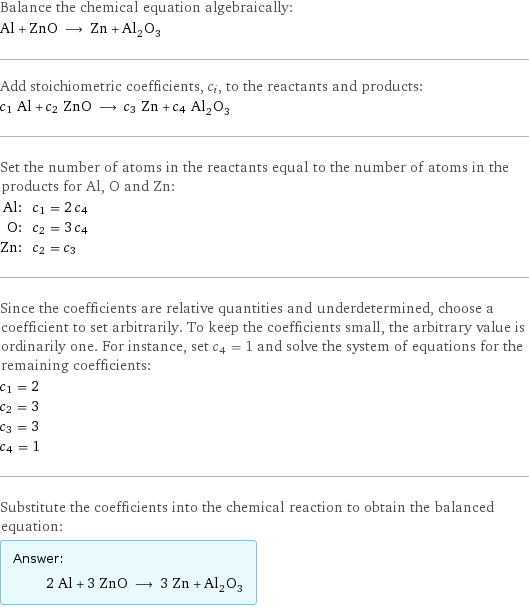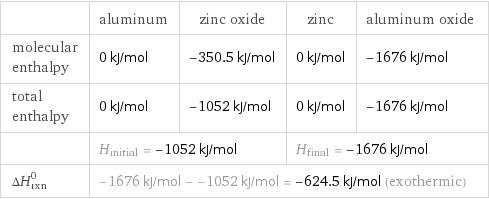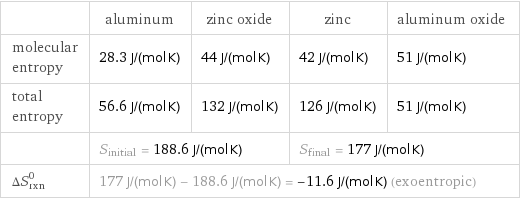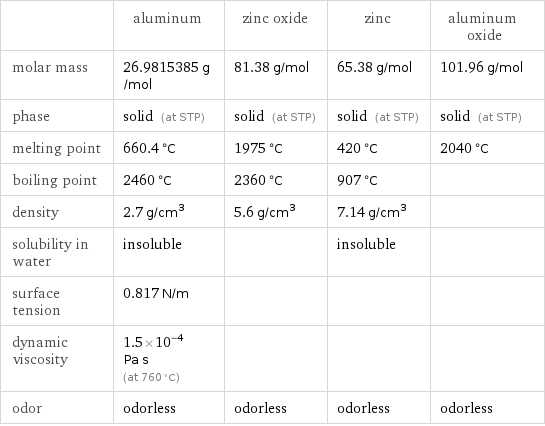Input interpretation

Al aluminum + ZnO zinc oxide ⟶ Zn zinc + Al_2O_3 aluminum oxide
Balanced equation

Balance the chemical equation algebraically: Al + ZnO ⟶ Zn + Al_2O_3 Add stoichiometric coefficients, c_i, to the reactants and products: c_1 Al + c_2 ZnO ⟶ c_3 Zn + c_4 Al_2O_3 Set the number of atoms in the reactants equal to the number of atoms in the products for Al, O and Zn: Al: | c_1 = 2 c_4 O: | c_2 = 3 c_4 Zn: | c_2 = c_3 Since the coefficients are relative quantities and underdetermined, choose a coefficient to set arbitrarily. To keep the coefficients small, the arbitrary value is ordinarily one. For instance, set c_4 = 1 and solve the system of equations for the remaining coefficients: c_1 = 2 c_2 = 3 c_3 = 3 c_4 = 1 Substitute the coefficients into the chemical reaction to obtain the balanced equation: Answer: | | 2 Al + 3 ZnO ⟶ 3 Zn + Al_2O_3
Structures

+ ⟶ +
Names

aluminum + zinc oxide ⟶ zinc + aluminum oxide
Reaction thermodynamics
Enthalpy

| aluminum | zinc oxide | zinc | aluminum oxide molecular enthalpy | 0 kJ/mol | -350.5 kJ/mol | 0 kJ/mol | -1676 kJ/mol total enthalpy | 0 kJ/mol | -1052 kJ/mol | 0 kJ/mol | -1676 kJ/mol | H_initial = -1052 kJ/mol | | H_final = -1676 kJ/mol | ΔH_rxn^0 | -1676 kJ/mol - -1052 kJ/mol = -624.5 kJ/mol (exothermic) | | |
Entropy

| aluminum | zinc oxide | zinc | aluminum oxide molecular entropy | 28.3 J/(mol K) | 44 J/(mol K) | 42 J/(mol K) | 51 J/(mol K) total entropy | 56.6 J/(mol K) | 132 J/(mol K) | 126 J/(mol K) | 51 J/(mol K) | S_initial = 188.6 J/(mol K) | | S_final = 177 J/(mol K) | ΔS_rxn^0 | 177 J/(mol K) - 188.6 J/(mol K) = -11.6 J/(mol K) (exoentropic) | | |
Equilibrium constant
![Construct the equilibrium constant, K, expression for: Al + ZnO ⟶ Zn + Al_2O_3 Plan: • Balance the chemical equation. • Determine the stoichiometric numbers. • Assemble the activity expression for each chemical species. • Use the activity expressions to build the equilibrium constant expression. Write the balanced chemical equation: 2 Al + 3 ZnO ⟶ 3 Zn + Al_2O_3 Assign stoichiometric numbers, ν_i, using the stoichiometric coefficients, c_i, from the balanced chemical equation in the following manner: ν_i = -c_i for reactants and ν_i = c_i for products: chemical species | c_i | ν_i Al | 2 | -2 ZnO | 3 | -3 Zn | 3 | 3 Al_2O_3 | 1 | 1 Assemble the activity expressions accounting for the state of matter and ν_i: chemical species | c_i | ν_i | activity expression Al | 2 | -2 | ([Al])^(-2) ZnO | 3 | -3 | ([ZnO])^(-3) Zn | 3 | 3 | ([Zn])^3 Al_2O_3 | 1 | 1 | [Al2O3] The equilibrium constant symbol in the concentration basis is: K_c Mulitply the activity expressions to arrive at the K_c expression: Answer: | | K_c = ([Al])^(-2) ([ZnO])^(-3) ([Zn])^3 [Al2O3] = (([Zn])^3 [Al2O3])/(([Al])^2 ([ZnO])^3)](../image_source/d0cfdf9e5210a99fb8770c062199c725.png)
Construct the equilibrium constant, K, expression for: Al + ZnO ⟶ Zn + Al_2O_3 Plan: • Balance the chemical equation. • Determine the stoichiometric numbers. • Assemble the activity expression for each chemical species. • Use the activity expressions to build the equilibrium constant expression. Write the balanced chemical equation: 2 Al + 3 ZnO ⟶ 3 Zn + Al_2O_3 Assign stoichiometric numbers, ν_i, using the stoichiometric coefficients, c_i, from the balanced chemical equation in the following manner: ν_i = -c_i for reactants and ν_i = c_i for products: chemical species | c_i | ν_i Al | 2 | -2 ZnO | 3 | -3 Zn | 3 | 3 Al_2O_3 | 1 | 1 Assemble the activity expressions accounting for the state of matter and ν_i: chemical species | c_i | ν_i | activity expression Al | 2 | -2 | ([Al])^(-2) ZnO | 3 | -3 | ([ZnO])^(-3) Zn | 3 | 3 | ([Zn])^3 Al_2O_3 | 1 | 1 | [Al2O3] The equilibrium constant symbol in the concentration basis is: K_c Mulitply the activity expressions to arrive at the K_c expression: Answer: | | K_c = ([Al])^(-2) ([ZnO])^(-3) ([Zn])^3 [Al2O3] = (([Zn])^3 [Al2O3])/(([Al])^2 ([ZnO])^3)
Rate of reaction
![Construct the rate of reaction expression for: Al + ZnO ⟶ Zn + Al_2O_3 Plan: • Balance the chemical equation. • Determine the stoichiometric numbers. • Assemble the rate term for each chemical species. • Write the rate of reaction expression. Write the balanced chemical equation: 2 Al + 3 ZnO ⟶ 3 Zn + Al_2O_3 Assign stoichiometric numbers, ν_i, using the stoichiometric coefficients, c_i, from the balanced chemical equation in the following manner: ν_i = -c_i for reactants and ν_i = c_i for products: chemical species | c_i | ν_i Al | 2 | -2 ZnO | 3 | -3 Zn | 3 | 3 Al_2O_3 | 1 | 1 The rate term for each chemical species, B_i, is 1/ν_i(Δ[B_i])/(Δt) where [B_i] is the amount concentration and t is time: chemical species | c_i | ν_i | rate term Al | 2 | -2 | -1/2 (Δ[Al])/(Δt) ZnO | 3 | -3 | -1/3 (Δ[ZnO])/(Δt) Zn | 3 | 3 | 1/3 (Δ[Zn])/(Δt) Al_2O_3 | 1 | 1 | (Δ[Al2O3])/(Δt) (for infinitesimal rate of change, replace Δ with d) Set the rate terms equal to each other to arrive at the rate expression: Answer: | | rate = -1/2 (Δ[Al])/(Δt) = -1/3 (Δ[ZnO])/(Δt) = 1/3 (Δ[Zn])/(Δt) = (Δ[Al2O3])/(Δt) (assuming constant volume and no accumulation of intermediates or side products)](../image_source/0fff62ea3286a1e0b907c25cc236740a.png)
Construct the rate of reaction expression for: Al + ZnO ⟶ Zn + Al_2O_3 Plan: • Balance the chemical equation. • Determine the stoichiometric numbers. • Assemble the rate term for each chemical species. • Write the rate of reaction expression. Write the balanced chemical equation: 2 Al + 3 ZnO ⟶ 3 Zn + Al_2O_3 Assign stoichiometric numbers, ν_i, using the stoichiometric coefficients, c_i, from the balanced chemical equation in the following manner: ν_i = -c_i for reactants and ν_i = c_i for products: chemical species | c_i | ν_i Al | 2 | -2 ZnO | 3 | -3 Zn | 3 | 3 Al_2O_3 | 1 | 1 The rate term for each chemical species, B_i, is 1/ν_i(Δ[B_i])/(Δt) where [B_i] is the amount concentration and t is time: chemical species | c_i | ν_i | rate term Al | 2 | -2 | -1/2 (Δ[Al])/(Δt) ZnO | 3 | -3 | -1/3 (Δ[ZnO])/(Δt) Zn | 3 | 3 | 1/3 (Δ[Zn])/(Δt) Al_2O_3 | 1 | 1 | (Δ[Al2O3])/(Δt) (for infinitesimal rate of change, replace Δ with d) Set the rate terms equal to each other to arrive at the rate expression: Answer: | | rate = -1/2 (Δ[Al])/(Δt) = -1/3 (Δ[ZnO])/(Δt) = 1/3 (Δ[Zn])/(Δt) = (Δ[Al2O3])/(Δt) (assuming constant volume and no accumulation of intermediates or side products)
Chemical names and formulas

| aluminum | zinc oxide | zinc | aluminum oxide formula | Al | ZnO | Zn | Al_2O_3 Hill formula | Al | OZn | Zn | Al_2O_3 name | aluminum | zinc oxide | zinc | aluminum oxide IUPAC name | aluminum | oxozinc | zinc | dialuminum;oxygen(2-)
Substance properties

| aluminum | zinc oxide | zinc | aluminum oxide molar mass | 26.9815385 g/mol | 81.38 g/mol | 65.38 g/mol | 101.96 g/mol phase | solid (at STP) | solid (at STP) | solid (at STP) | solid (at STP) melting point | 660.4 °C | 1975 °C | 420 °C | 2040 °C boiling point | 2460 °C | 2360 °C | 907 °C | density | 2.7 g/cm^3 | 5.6 g/cm^3 | 7.14 g/cm^3 | solubility in water | insoluble | | insoluble | surface tension | 0.817 N/m | | | dynamic viscosity | 1.5×10^-4 Pa s (at 760 °C) | | | odor | odorless | odorless | odorless | odorless
Units
